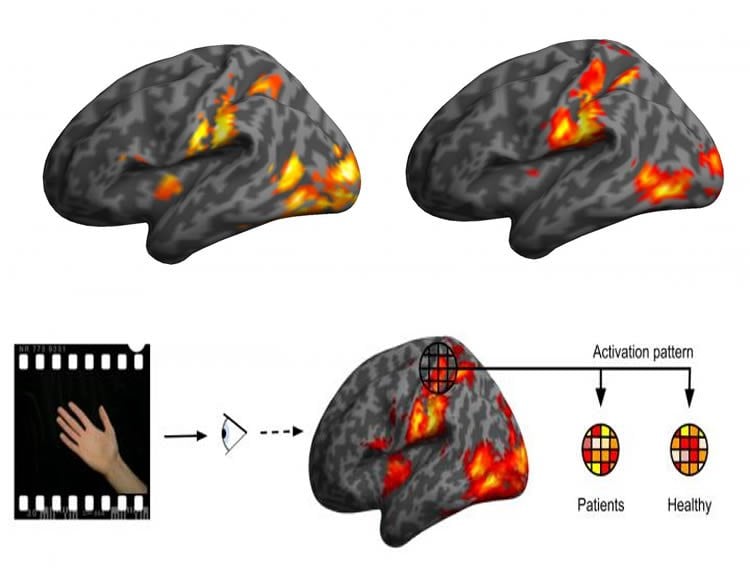Summary: Researchers report abnormal activation in areas that respond to normal pain when a person with CRPS witnesses another person experience painful stimuli.
Source: Aalto University.
Some people claim to experience pain just watching something painful to happen. This is true especially of people suffering from complex regional pain syndrome (CRPS), a disabling chronic pain disorder in a limb. In CPRS patients, both own movements and just observing other persons’ movements may aggravate the pain.
When you hurt yourself, pain receptors in the body send signals to different parts of the brain. As the result, you experience pain. Researchers in Aalto University, Finland, found that when CRPS patients feel pain caused by observing other person’s movements, their brains display abnormal activation in many such areas that respond to normal physical pain. Thus the pain that the CRPS patients felt during movement observation presented similarities to the “normal” pain associated with tissue damage.
“CPRS is a very complex disease with devastating chronic pain. Its pathophysiology is incompletely understood and definitive biomarkers are lacking. Our discovery may help to develop diagnostics and therapeutic strategies for CRPS patients,” said neurologist Jaakko Hotta, Doctoral Candidate at Aalto University.
In the study, the researchers analyzed functional magnetic resonance images from 13 upper-limb CRPS patients and 13 healthy control subjects who were viewing brief videos of hand actions, such as a hand squeezing a ball with maximum force.

In the CPRS patients, watching hand actions was associated with abnormal brain activation patterns and a pattern-classification analysis differentiated the patients from the healthy subjects. These findings indicate that CRPS affects brain areas related to both pain processing and motor control.
Source: Jaakko Hotta – Aalto University
Image Source: NeuroscienceNews.com image is credited to Jaakko Hotta/Aalto University.
Original Research: Abstract for “Abnormal brain responses to action observation in complex regional pain syndrome” by Jaakko Hotta, Jukka Saari, Miika Koskinen, Yevhen Hlushchuk, Nina Forss, Riitta Hari in Journal of Pain. Published online November 12 2016 doi:10.1016/j.jpain.2016.10.017
[cbtabs][cbtab title=”MLA”]Aalto University “Just Watching Hurts! Signs of Pain Seen in the Brain.” NeuroscienceNews. NeuroscienceNews, 29 November 2016.
<https://neurosciencenews.com/pain-neurology-crps-5624/>.[/cbtab][cbtab title=”APA”]Aalto University (2016, November 29). Just Watching Hurts! Signs of Pain Seen in the Brain. NeuroscienceNew. Retrieved November 29, 2016 from https://neurosciencenews.com/pain-neurology-crps-5624/[/cbtab][cbtab title=”Chicago”]Aalto University “Just Watching Hurts! Signs of Pain Seen in the Brain.” https://neurosciencenews.com/pain-neurology-crps-5624/ (accessed November 29, 2016).[/cbtab][/cbtabs]
Abstract
Abnormal brain responses to action observation in complex regional pain syndrome
Patients with complex regional pain syndrome (CRPS) display various abnormalities in central motor function, and their pain is intensified when they perform or just observe motor actions. Here, we examined the abnormalities of brain responses to action observation in CRPS. We analyzed 3-T functional magnetic resonance images from 13 upper-limb CRPS patients (all females, ages 31–58 years) and 13 healthy, age- and sex-matched control subjects. The functional magnetic resonance imaging data were acquired while the subjects viewed brief videos of hand actions shown in the first-person perspective. A pattern-classification analysis was applied to characterize brain areas where the activation pattern differed between CRPS patients and healthy subjects. Brain areas with statistically significant group differences (q < 0.05, false discovery rate corrected) included the hand representation area in the sensorimotor cortex, inferior frontal gyrus, secondary somatosensory cortex, inferior parietal lobule, orbitofrontal cortex, and thalamus. Our findings indicate that CRPS impairs action observation by affecting brain areas related to pain processing and motor control.
Perspective
This article shows that in CRPS, the observation of others’ motor actions induces abnormal neural activity in brain areas essential for sensorimotor functions and pain. These results build the cerebral basis for action observation impairments in CRPS.
“Abnormal brain responses to action observation in complex regional pain syndrome” by Jaakko Hotta, Jukka Saari, Miika Koskinen, Yevhen Hlushchuk, Nina Forss, Riitta Hari in Journal of Pain. Published online November 12 2016 doi:10.1016/j.jpain.2016.10.017







